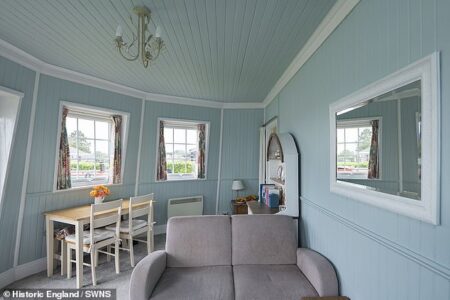A converted helter-skelter is among five stunning waterside properties that are set to be converted into Grade II-listed status.
The unique eight-sided building in the Broads National Park in Norfolk is a ‘distinctive, local landmark’, according to Duncan Wilson, Historic England’s chief executive.
The Dutch Tutch in Potter Heigham started off as a helter-skelter at the end of the Britannia Pier in Great Yarmouth.
It stands on the bank of the River Thurne and is said to be one of the most instantly recognisable, and most photographed, buildings in Broadland.
It has stood in the same spot for the last century and the helter-skelter was once named ‘On The Mat’.

Dutch Tutch in Potter Heigham, Norfolk, has been newly listed as Grade II after being converted from part of a seaside helter-skelter

The Dutch Tutch was originally a helter-skelter at the end of the Britannia Pier in Great Yarmouth. Pictured: Inside the building

The remains of the amusement ride were transported to the quaint village of Potter Heigham and converted into a two-storey holiday cottage
The fairground ride was located near to the entrance of the pier, which was built in 1902, and Edwardian thrill seekers paid a fee of 1p per ride.
Then in December 1909, disaster struck as the pier and pavilion caught fire as the town’s population gathered on the beach to witness the tragedy.
It is believed that the helter-skelter building also sustained some fire damage but, the following year was moved to Potter Heigham, possibly by wherry.
After the relocation, the bottom section became a holiday cottage while the top was placed beside it and utilised as an outside toilet.
The upper floor of the cottage was initially reached via an outdoor staircase which was enclosed at a later date with the extension that is seen on the side of the building today.
The very top of the structure was used as an outbuilding at the waterside chalet.
The pier itself was rebuilt in 1910 and a new pavilion was opened but it sadly suffered the same fate as its predecessor when just four years later a fire broke out on the structure.
At the time it was believed to have been started deliberately and was rumoured locally to have been the work of the suffragettes, according to Broadland Memories.
A third pavilion was built and continued to attract hundreds of visitors until WWII began.
The Dutch Tutch was once called ‘On The Mat’ as a fairground ride
A fire ravaged the pier in 1909 and part of the ride was damaged
The first Brittania Pier opened in July 1858, was constructed entirely of wood and was 700ft in length but the following year it was left badly damaged when a sailing vessel collided with it.
The former helter-skelter has been listed at Grade II by the Department for Culture, Media and Sport on the advice of Historic England, alongside four other waterside chalets.
These include prefabricated structures by the company who created Scott’s Antarctic expedition huts, and one of the only remaining eel setts – a place for eel catchers to put out nets at night – in England.
The Grade II listed waterside buildings include the Dutch Tutch, Tower View, The Eel Sett and The Holt in Potter Heigham, and Staithcote in Wroxham – and are all within the Broads National Park.
The Norfolk Broads are the largest stretch of wetlands in the UK.
From the ninth Century, peat cut from the Norfolk marshes was used as a popular source of fuel.
They were created naturally when the sea level rose and flooded the area in the 14th Century.
Dutch experts were invited to carry out drainage work after the floods.
They left their mark on the area with their own style of architecture, seen mainly in the design of barns and roofing.


